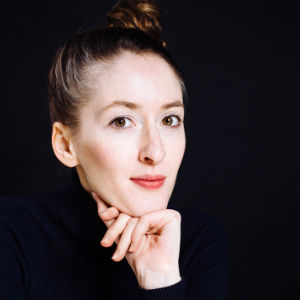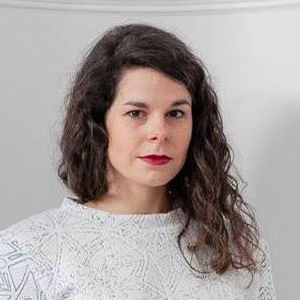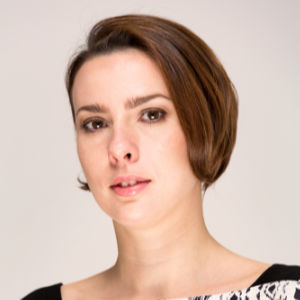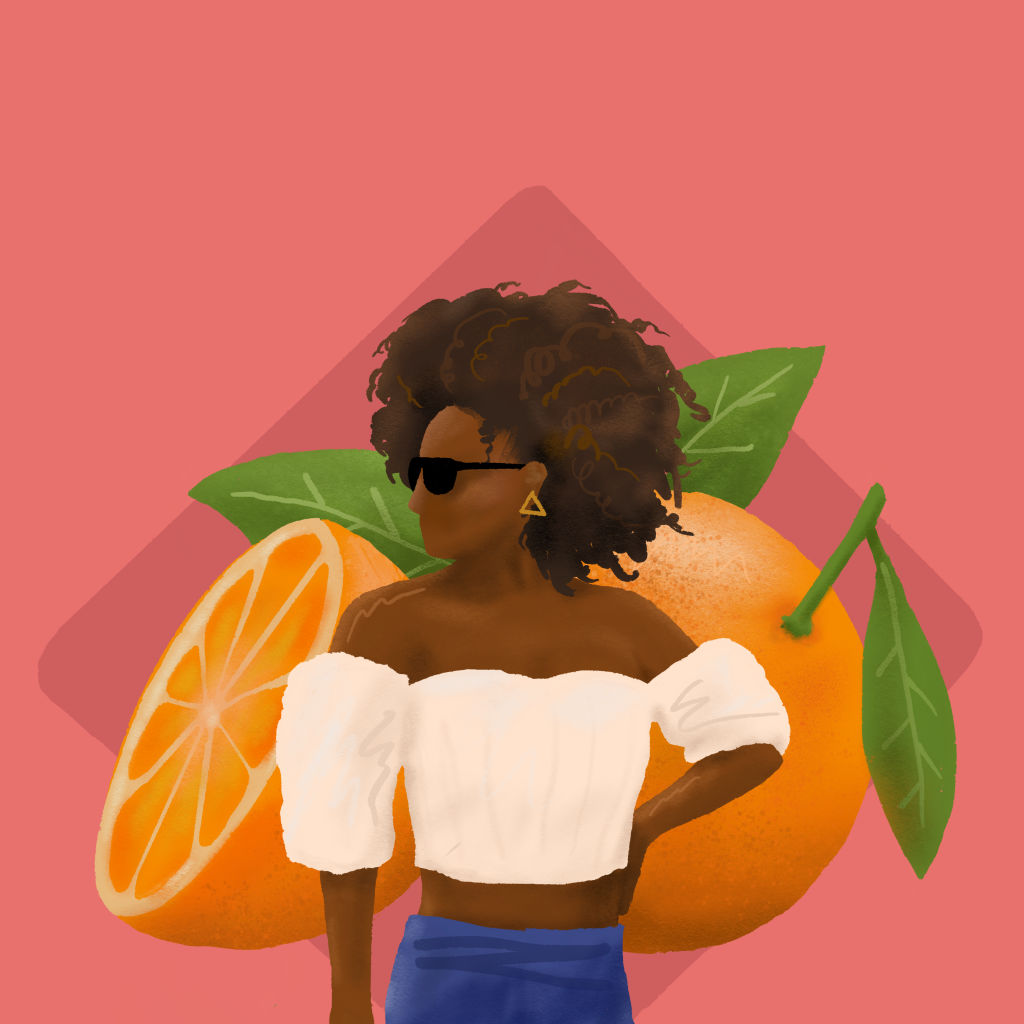#2 Forward Fashion
The fashion industry is one of the most resource-intensive industries in the world. But some are rolling up their sleeves and moving the needle. How can we, as consumers, do better and what is the responsibility of the industry? These three voices will try to provide some answers.

Cherie Birkner
While she had everything in her hands for a long career in the traditional fashion world, Cherie started having doubts. Was her job in line with her personal values? She decided to become a photographer, focusing on the good guys who are moving the industry in the right direction. It was the spark for Sustainable Fashion Matterz, where she showcases and spreads knowledge about sustainable fashion.

Soraya Wancour
As a young and ambitious fashion designer, Soraya tackles the industry from three angles with Studio AMA, a lab for ethical fashion. Her clothes are made exclusively from discarded textiles, they are produced locally in sheltered workplaces, and sold directly to consumers. We went to take a look in her atelier.

Enrica Arena
One of the many sustainable fabrics that have emerged in the past years, Orange Fiber is sourced from the mountains of citrus waste generated in Italy every year. Co-founder Enrica will tell you how and why this all came to be, and how they try to shape the industry from the inside out.
Additional notes & links
- 6 years after the Rana Plaza collapse, the situation in Bangladesh is still unsatisfactory. Which is why this week (April 22-28) is Fashion Revolution week, prompting everyone to ask #whomademyclothes at events and projects in more than a hundred countries.
- It’s hard to gauge exactly how polluting the fashion industry is. This Racked article dives deep and is filled with interesting facts and figures.
- Here are some of the innovative materials mentioned in this episode: Lyocell from wood pulp, SeaCell and AlgiKnit from seaweed, Piñatex pineapple leather, and Muskin from mushrooms.
Credits
🎵 All music by Lennart Schoors, except:
Lee Rosevere – Start The Day
Lee Rosevere – Let That Sink In
Lee Rosevere – Thoughtful
📷 Pictures:
Picture of Cherie Birkner by Cherie Birkner
Picture of Soraya Wancour by Anyuta Snauwaert Wiazemsky
Transcript
Closet dive
[DOORS OPEN, HANGERS RATTLE]
Mei Van Walleghem: We’re standing in front of my closet. It contains an amalgam of things. Some of it consciously chosen, others things maybe pieces I’m not so proud of. But let’s look at this, these are my favourite pair of pants for example. I’ve been wearing them for the last, I don’t know, five … seven years and they’re basically worn to shreds right now, so I’m in desperate need of a new pair. But if I look at the tag, they’re from a brand that’s probably not that ethical or sustainable, while the pants I’m wearing they cost about six times as much. Consciously chosen, from an ethical brand, let’s not name names, but I’m really not that happy with them. Because they’re already showing signs of wear after just a few washes, so it’s not at all what I expect from a piece of clothing in that price range. So this leaves me with a dilemma. I’m in the market for a new pair of pant, as I told you, but I don’t want to have this conversation again in a year, while I do want to make sustainable choices. I really don’t know where to start. All I know is that I can do better.
Lennart Schoors: This is Tomorrow People
Mei: a show about building a better tomorrow, today.
Lennart: I’m Lennart
Mei: and my name is Mei
Mei: The fashion industry as a whole is not exactly clean. It’s one of the most resource-intensive industries in the world, both in terms of natural resources and human resources. So there’s the environmental impact, and there’s the unethical working circumstances for a considerable part of the workforce. Sadly, today marks the 6th anniversary of the Rana Plaza factory collapse in Bangladesh, which killed more than a thousand people and injured many more, on April 24, 2013.
Cherie Birkner (Sustainable Fashion Matterz)
Lennart: There are bright spots on the map however. To guide us through the labyrinth of forward fashion, we gave Cherie Birkner a call.
Cherie Birkner: I’m Cherie Birkner, I’m a freelance photographer and the founder of Sustainable Fashion Matterz.
Lennart: Cherie, a German-American based in Berlin, really grew up in fashion.
Cherie: And I’ve been in the fashion industry since I was I was a teenager. I used to work as a model, and sometimes I’d help in sales during fashion week.
Lennart: And, you know, she had big dreams
Cherie: What I just wanted was to walk down the street and then see someone wearing something I designed, and I thought that would be the most amazing feeling.
Lennart: So she went on to study fashion design and pretty soon…
Cherie: I had a job offer as creative director for a company I had been working with for a few years, which was a fast fashion company.
Lennart: Fast fashion is the term often used to describe the large retailers of mass produced, inexpensive and often inferior quality clothing, released in multiple collections every year. You know, the typical stores you can find in every city. It was a great experience, she says, but gradually she came to see the less pretty side of it all.
Cherie: And one time, we had all these boxes piling up with all the pieces that had small flaws and I was trying to find places we could donate it to. Nobody wanted it! You know, most people when they’re in need of clothes they don’t need a pair of skinny jeans, what the need is a warm coat or warm sock, something like that.
Lennart: The frustration grew, and the last straw came at an unexpected moment.
[MUSIC]
Cherie: Actually, I was on a date with someone and I said something, I don’t even remember what, and they like on a side-note he was like, “actually Cherie, you’re just a good person. And in that moment I was just … I started questioning myself. And essentially I came to realise that my actions did not at all fit my value. And then I went on Greenpeace and just cried my eyes out all day essentially, realising what I was doing in the fashion industry. It was like someone was holding my mouth shut. And then I just quit right away, so yeah…
Lennart: She had always been into photograpy, so she decided to pick that up again.
Cherie: I decided to take portraits of people who are making a difference in the fashion industry. Because I though, you know, these are the people who I’d really want to be working with, people who share my values. And that’s kind of how Sustainable Fashion Matterz started.
Lennart: What began as a handful of portraits and interviews of eco-fashion influencers, quickly grew into what it is today: a whole website filled with useful information, and a network of people and brands within sustainable fashion. Of course, it all starts with the question, “What is sustainable fashion?”.
Cherie: You know, I always say there’s no such thing as 100% sustainable fashion. But there’s always a more sustainable way of doing things. There’s two ways to view it. You can see what is a sustainable fashion brand and what is a sustainable consumer. Because, just because a brand produces fair trade organic cotton pieces, if I buy a new one of those every week that’s not a sustainable consumer behaviour.
Mei: So if I understand this correctly, what Cherie’s saying is that I shouldn’t feel guilty about purchasing that cheap pair of pants. Granted, they were hardly my most sustainable piece in the wardrobe, but in the end, using them for years beats buying a sustainable piece and only wearing it ten times.
Lennart: Exactly. There’s an alternative to fast fashion, they call it, surprise surprise, slow fashion. But it encompasses much more than just the production of the garments. For us as a consumer, that could mean only buying what you really need or want. So when you go out to buy that new pair of pants, Mei, ask yourself:
Cherie: How often am I gonna wear this piece? Will I still like this in a few years or is it super on-trend right now and I might not like it anymore. How is the quality, if the quality is really good. I think it’s important that everyone goes as far as it is comfortable for them. You know, one small the is so much better than no step at all.
Lennart: Once you’ve taken care of the principle of not buying more than you need, you can start looking for pieces that were produced under fair circumstances, or manufactured locally, clothing that is vegan, or recycled, etcetera. There are also dozens of certifications and labels, but it’s tricky to figure out what they all mean. So if you want to dive deeper into this topic, Cherie’s website can get you started – we’ll link it on tomorrowpeople.today.
Mei: You know, one of my biggest issues with sustainable fashion is that, although a wide range styles and sizes is already available now, it takes some effort to find them, and they remain remarkably more expensive. I am however willing to pay more to get a quality piece, but frankly it’s a little discouraging sometimes.
Lennart: Yeah, I’m afraid that’s the trap of supply and demand. While we’re waiting for the economies of scale to kick in, there are alternatives. It’s like Cherie says…
Cherie: Consumers have great power, because in the end of the day they are the ones who are buying these products. And if there’s no buyer, then they’re not going to be made. I always say, if you don’t have a budget, go second-hand shopping. And if you’re not in a big city, where they have huge selections of all kinds of second-hand shops, there’s so many online platforms where you can buy cool second-hand pieces.
Mei: Second-hand shopping is definitely a great way for consumers to give garments a second or even third life. But sometimes the textile industry produces fabrics that never even make it into a product or a garment in the first place. These prototypes, tests and sometimes leftovers usually end up burned, shredded or just on a landfill. Unless someone cares enough to save them…
Soraya Wancour (Studio AMA)
Mei: On a frigid and gray morning we visited Soraya Wancour at her home.
Soraya Wancour: My name is Soraya Wancour, I’m a … uh … a fashion designer
Mei: Do you hear that hesitation in her voice? Even though Soraya got a professional training in textile design at the renowned arts school of La Cambre in Brussels, she feels a little uncomfortable with the whole fashion world.
Soraya: Fashion nowadays has this ‘show’ image.
Mei: You know, fancy haute couture spectacles on one hand, and cheap, exploitative fast fashion on the other hand.
Soraya: That’s not the way to go for me in fashion. think as entrepreneurs in general, we have to be more conscious and more responsible when it comes to the impact we make. On the other hand, I want to be a fashion designer really spotting these opportunities and creating a business model which is according to the needs of people and planet today.
Mei:She formed these values and principles as a teenager, when she was infatuated with second-hand clothes.
Soraya: Every week I went to the local thrift shop to check the new items, because I was very fond of clothing and I really liked to dig in and to create a style. I had that age where that was kind of important. But instead of the big brands I just wanted to search my own thing.
Mei: It was there that she noticed…
Soraya: People throw away so much clothing. This shop is filled with so much and every week there’s new things. That’s crazy if you think about it. And also, I felt this love for material. So I wanted to keep things in loop very quickly.
Mei: After her studies, Studio AMA was born. It’s the company where Soraya wants to fully implement her philosophy, in three distinct ways: There’s the ecological aspect, so the clothes are made exclusively from discarded textiles. Secondly, there’s a social aspect to the production,. Everything is made locally in sheltered workshops. And finally, she only sells directly to consumers at fair prices. To get a feel for the materials she works with, we went up the stairs to have a look in her atelier.
[GOING UP THE STAIRS]
Soraya: I live and work here. So I always have the newest materials that I work with, like this for instance… [fade]
Mei: There were boxes and bags and more boxes, all filled with scraps of salvaged textiles.
Soraya: I’m also working on flax prototypes… and the linen, the mattress cover and then the elastics and the others.
Mei: So every item you sell goes through your own hands finally, at the end.
Soraya: Yeah! … I’m always doing the embroideries myself. I hope that one day I don’t have to do it myself anymore. So I put this on … It makes really funny noises.
[MUSIC]
Mei: You’ve made sweaters from mattress fabric covers, you’ve made bags from materials that would be discarded otherwise. Where do you find those materials? How do you source them?
Soraya: Here we live in an area where there is a very rich history of textiles. Even today there is a lot of textile industry and basically what I’m doing is: I look them up, I call them, I explain to them what I’m doing and I ask them if I can check their containers before the fabrics are just … before they get discarded.
Mei: So you basically go dumpster diving with the fabric industry. How do they react to that? Do they say “Oh, just take whatever you want”, or are they really interested in what you’re going to do with it?
Soraya: It’s difficult for me to gain their trust. I really explain to them that I want to make sustainable fashion out of their trash and I show them what I make. They are interested at a certain level in what I’m doing with this, but I think they don’t fully see the opportunities that I’m giving to them.
Mei: Opportunities like showing their own customers how they’re turning the inevitable waste into new products. In a world where awareness of sustainability is growing, and increasingly guiding consumers’ choices, a story like this could be a great market advantage.
Soraya: That’s a goal for me in this textile industry, to really make them think twice about capacities of their stuff.
Mei: Which is why AMA is more than just a company that produces and sells clothes. In her ethical fashion lab Soraya offers workshops, shares her knowledge, and informs consumers as well as the industry.
Soraya: In general a consumer is rather lazy and they expect from the industry to come up with the bright ideas and to be responsible for consumers. To take a responsibility for consumers about their impact. But that means that, as an entrepreneur, as a business, you need to be super super transparent about what you’re doing…
Mei: For instance by informing potential buyers about the origins of the fabric, how and where they were processed, what they are doing to minimise their footprint, etcetera. There should be a dialogue between customers and brands.
Soraya: And if we’re able to really let them talk to each other, what I‘m trying to do, then we can reach so much more.
[MUSIC]
Lennart: After the break, we’ll meet another brand that has a wonderful story to tell…
Break
Mei: If you like what you’re hearing here on Tomorrow People, why not post about it on social media, or tell your friends and family? If they’re new to podcasts, we have a page up on our website that explains how it all works, and how to subscribe. You can find it on tomorrowpeople.today.
Lennart: Another great way you can support us is by leaving a rating and review, for example on Apple Podcasts. It all helps us spread the stories of the Tomorrow People.
Enrica Arena (Orange Fiber)
Lennart: A big part of sustainable fashion is innovation in materials. Doing research for this episode, we came across many wild and wonderful textiles: there’s Lyocell made from wood pulp, AlgiKnit and SeaCell harvested from seaweed, Piñatex – a leather alternative made from the leaves of pineapples, there’s Muskin made from mushrooms, and many more… Like this one.
[JUICING]
Lennart: Okay, we’re now in the kitchen, making orange juice. You know, when juicing oranges, you end up with a lot of waste every time? We just throw it in the compost of course, but do you ever wonder what they do with this waste, this byproduct, on an industrial scale?
Enrica Arena: More than half the weight of a fresh orange, after it is juiced, is basically a byproduct.
Lennart: Meet Enrica Arena. She’s the co-founder and CMO of Orange Fiber, a company from Catania, a vibrant historic city at the foot of the Etna volcano, on the Italian island of Sicily.
[SEAGULLS]
Enrica: Sicily is traditionally a land where oranges are grown, and consumed, and squeezed.
Lennart: Every year, more than 700.000 tons of “pastazzo” are produced – that’s what the Italians call the citrus waste. Disposing of it is an expensive process, even prompting a few companies to illegal dumping. But about 7 years ago, Enrica and co-founder Adriana Santanocito had an idea.
Enrica: Adriana, who was studying fashion design back then in Milan, we were flat mates, she imagined that she could create a fabric from oranges.
Lennart: It didn’t take long before they arrived at the pastazzo, and came up with a chemical process…
Enrica: To basically extract the cellulose that can be spun and transformed into fabric.
Lennart: Cellulose is a molecule, and a key component of the cells in plants. It is what makes their stems, their leaves, their branches so strong. So things like wood, paper, cotton and other fibers are all bound together by long chains of cellulose. Adriana and Enrica discovered a way to separate the cellulose from the citrus waste, purify it, and spin it into a yarn. So, they got a patent for it.
Enrica: Back then the idea was, ok let’s just sell the patent? Then we found basically that everybody was looking to see a prototype first. So the only chance to see this happening, was make it by ourself.
Lennart: The result is a very soft fabric that’s very similar to silk in terms of look and feel. But they can also combine it.
Enrica: From the yarn, which is a 100% oranges, we can weave it in blend with other materials.
Lennart: Other materials like cotton, or elastane, depending on the needs. Using the existing infastructure of the Italian textile industry, they ramped up production and found their first clients. It was a lot of hard work, with ups and downs, but Orange Fiber is a thriving company now. It’s notable that all aspects of the production happen in Europe.
Enrica: It’s very, very important because we want to have an impact not just on the environment but also giving new opportunities and new life to an existing supply-chain that maybe is looking for innovation and can benefit from our invention.
Lennart: Orange Fiber is a high end fabric, which is reflected in its price. Do you think that the prices will go down if the demand picks up?
Enrica: For sure, I mean we can’t compete with processes that have been there for hundreds of years, that have economies of scale and big batches of production. I think in the long run this can change. But I also think there’s something good in keeping the price-point where you are encouraged to take care of your garment, because you attach a higher value to them. Whether that’s because of sustainability, whether that’s because of quality or whether that’s also because of the price tag that was attached.
Mei: I saw that Orange Fiber was one of the fabrics used in a new collection by H&M. Did you ask her how she preserves her sustainable ethics while collaborating with such a global fast fashion retailer?
Lennart: Well, the Swedish multinational does do a lot of research and development into sustainable clothing, and they have their conscious collection, but yes, critics say that it’s just a small drop in the bucket. They call it greenwashing, a sort of marketing spin to give your company an image that is more environmentally friendly than it actually is. I did ask Enrica about her take on greenwashing.
Enrica: I think everybody is looking for the balance between keeping their business alive but still being mindful about sustainable alternatives. We just can’t think that them or any other brand wake up one day and a hundred percent of their production is sustainable. We can’t ignore the fact that brands have been around with their products for years. So it’s really a process that will take years.
Lennart: So, it’s better to take small steps and change the system from within?
Enrica: I definitely think so.
[MUSIC]
Conclusion
Mei: There’s no shortage of good ideas and forward thinking entrepreneurs in the fashion world, each with their own approach. Some use the current establishment to make changes from within, while others try to emerge from the fringes. Whatever the approach, it’s not easy.
Soraya: I’m not there yet. Certainly when we’re talking about how I can make a living for myself, we’re not there yet.
Mei: If we want to minimise the impact of the fashion industry on our planet, we cannot just expect the consumers to reduce, reuse and recycle, nor just blame the industry for their practices. It’s clear that we’ll need support from all sides.
Cherie: You need to have the government doing stuff, you need to have consumer interest, you need to have brands focussing on it. You need to have brands showing hey, it’s actually possible to produce a sweater using less than ten percent of the amount of water that a regular sweater would cost.
Mei: Now, about that pair of pants I need, I’m glad to hear I’m not solely responsible for its footprint, but I can make a difference. Getting to know the story behind the brands I buy or looking into the materials. And who knows, I might just pass by the thrift shop on my way.
Credits
Lennart: This episode of Tomorrow People was produced, hosted, edited and scored by Lennart Schoors, and produced and hosted by Mei Van Walleghem. Additional music by Lee Rosevere. Many thanks to our guests Cherie Birkner, Soraya Wancour and Enrica Arena. Additional thanks to Em Mendoza and Heleen Klopper.
Mei: You can visit our website at tomorrowpeople.today. You can also follow us on Twitter, Facebook and Instagram, for previews and behind the scenes shots. And if you liked the show, tell your friends and leave a review on Apple Podcasts. It helps us spread the stories of the Tomorrow People. We’ll be back in two weeks, from Rotterdam rooftops, turning agriculture on its head.


 Apple Podcasts
Apple Podcasts
 Spotify
Spotify
 Google Podcasts
Google Podcasts
 Other
Other